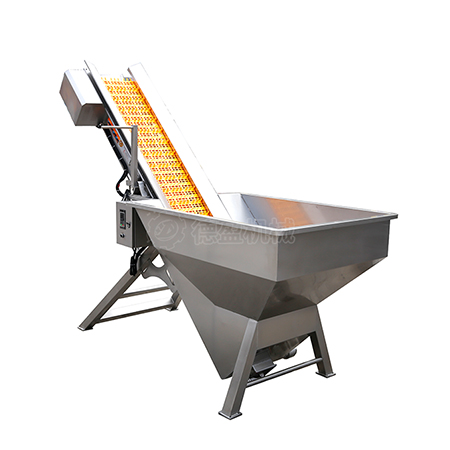A Food Soaking Conveyor is a specialized conveyor system used in the food processing industry for soaking food products in liquids to achieve processes such as marinating, cleaning, rinsing, disinfection, or flavor infusion. This equipment typically consists of a conveyor belt or chain and a series of soaking tanks. Food products are placed on the conveyor and immersed in the liquid-filled tanks, allowing them to undergo various treatments.
Food Soaking Conveyors are widely used in food processing facilities to enhance the flavor, cleanliness, and safety of food products. They are essential for marinating meat, cleaning fruits and vegetables, and ensuring the overall quality and hygiene of processed foods. The conveyor's design allows for efficient and consistent soaking, contributing to the overall efficiency and effectiveness of food processing operations.

Features
Vertical lifting capacity:
The grain elevator conveyor is designed for vertical conveying of granular and powdered materials, and can effectively lift large quantities of grain, such as wheat, rice, corn and soybeans.
Diversified design:
It can be belt-type or chain-type, and the appropriate structure can be selected according to the material characteristics and conveying height.
Compact structure:
The design occupies a small area, suitable for use in granaries or processing plants with limited space.
Strong sealing:
The conveyor shell has good sealing, which helps to prevent dust leakage and material loss.
High efficiency:
The conveying speed is fast and can meet the needs of large-scale grain processing.
Advantages
Efficient operation:
A large amount of material can be lifted per unit time, suitable for large-scale farms, granaries and processing plants.
Reduce labor costs:
Replace traditional manual handling, reduce labor intensity and improve work efficiency.
High operational safety:
Equipped with anti-slip device, anti-backflow system and overload protection device to reduce operating risks.
Strong durability:
Made of high-strength materials, it can adapt to long-term use in different environments.
Customizable:
Design different sizes, materials and lifting heights according to user needs to meet diverse production needs.
Specific applications
Agricultural field:
Used for post-harvest grain transportation and storage on farms, such as vertical lifting of corn, wheat, soybeans and other grains.
Granary storage:
Transport grain to high-level warehouses for storage to improve warehouse space utilization.
Food processing plants:
Transport raw materials from the ground to processing equipment, such as raw material processing in flour mills or rice processing plants.
Ports and docks:
Used for grain loading and unloading, in conjunction with ship loading or unloading operations.
Maintenance recommendations
Regular cleaning:
Regularly remove dust and residues inside the conveyor to prevent blockage and equipment damage.
Lubrication inspection:
Regularly check chains, bearings and transmission parts to ensure good lubrication and reduce friction loss.
Fastener inspection:
Regularly check the tension of bolts and chains to prevent malfunctions due to looseness.
Belt and roller inspection:
Make sure the belt is free of cracks and the roller rotates flexibly. If worn, replace it in time.
Safety device test:
Regularly check overload protection, anti-reverse device, etc. to ensure normal use in emergency situations.
FAQ
What should I do if the grain lifting efficiency is reduced?
Check whether the conveyor belt or chain is loose, and adjust the tension if necessary.
Clear the blocked material to ensure smooth transportation.
How to deal with the overload protection trigger?
After stopping, check whether the equipment is stuck, remove the stuck material and check whether the material flow is too high.
What is the reason for the equipment noise to increase?
It may be that the bearing lacks lubrication or the chain is severely worn. It is necessary to check the lubrication status and component wear.
How to prevent material backflow or overflow?
Ensure that the anti-reverse device works properly and check whether the material flow is uniform.
How to deal with excessive temperature during operation?
Stop the machine to check whether the friction parts are insufficiently lubricated or the belt is too tight, and make appropriate adjustments.
How to extend the service life of the equipment?
Use the equipment strictly according to the operating specifications, maintain and lubricate regularly, and avoid long-term overload operation.
| Technical Parameters | |
| Overall dimensions | 3250×1200×2100mm |
| Voltage | 380V |
| Power | 0.55kW |
| Output | 600-1200kg/h |